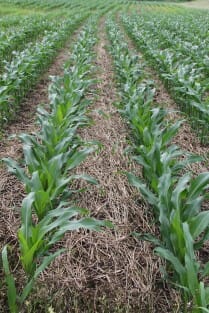Three New Resources for Cover Crop Success
While farmers have been getting busy planting, we PFI staff have been getting to work writing up resources to make sure the 2017 season is the best yet for cover crops. Check out these three NEW resources for farmers and crop advisers on the latest recommendations for cover crop selection and best management practices.
This fun, interactive sheet guides the user through the decision of what cover crop will work best in their operation. Following a series of yes or no questions about cover crop planting method and date leads the user to recommendations for cover crop varieties and seeding rates that will fit with their equipment and operation.

The journey begins with a question about planting date. Follow the link to the full decision tree to find your ideal cover crop.
A Recipe for Success: Corn Following a Cereal Rye Cover Crop
This spring has been a tough one for farmers planting corn after a cereal rye cover crop. With a warm February and then a cold and wet March many weren’t able to get into the fields to terminate the rye until April – a nerve-racking timeline for many farmers. So we polled our cover crop farmers about their key to a stress-free spring when they have cereal rye to terminate before corn. From the list of best practices they provided, we noted four key themes to a successful corn planting:

Healthy corn emerges through cereal rye residue on the farm of PFI member Tim Sieren near Keota, IA.
- When to Terminate – Wait until the rye is actively growing.
- How to Terminate – Don’t skimp on the herbicide, use the full recommended rate.
- Fertilizer – Use 30-50 lbs of starter Nitrogen.
- Planter Settings – Invest in the gadgets to close the seed trench.
Read the whole fact sheet at the link above for farmers’ specific recommendations on minimum temperatures for termination, preferred herbicide products and rates, fertilizer amounts and application methods and equipment add-on’s for planting through cover crop residue.
Developing a Winning Cover Crop Plan with Your Customer
A bonus for crop advisers – this worksheet walks through the planning steps for integrating cover crops into an existing rotation with a farmer. The worksheet prompts farmers to identify their goals for cover crops in their operation, where the cover crop fits within their rotation, and who will be responsible for the management activities associated with the cover crop. Though geared towards crop advisers, this tool is also useful for farmers who want to plan out their cover crop strategy on their own.
Check out our cover crop page for these and other resources on successfully integrating cover crops into corn and soybean rotations.
